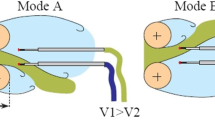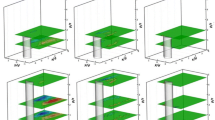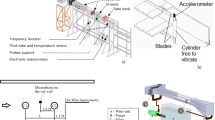Abstract
This paper presents an experimental study performed in an aerodynamic channel using hot-wire anemometers and flow visualization by injection of dye in water in a hydraulic channel of the flow on two rigid cylinders placed at several angular positions to the flow, from 0° (side-by-side) to 90° (tandem). The main objective is to analyze the effects of the angular positions on the wake flow and the occurrence of bistability. Signal analysis was performed by means of Fourier and discrete and continuous wavelets transform. Time series of the angle of the flow emanating from the cylinder gap related to the main flow direction were obtained from flow visualization analysis to track the flow mode change in the water flow. Results from the aerodynamic channel showed the presence of bistability only for side-by-side configuration, and some attempts to modify the flow mode for 2.5° and 5° while through the flow visualization the flow mode changes were present for side-by-side and for 2.5° configurations. For the other angles investigated, the presence of a narrow and a wide wake without flow mode changes was observed. The difference between the results for 2.5° suggests that the scales and inertia involved in bistability phenomenon may affect the phenomenon. For 75°, the wide wake is so vigorous that it overwhelmed the narrow wake, displacing it downwards, and increasing the amplitude of the vertical component of the wake compared to smaller angles. The phenomena analyzed can be seen as two-dimensional for all cases, but the presence of vertical components shows that the resulting flow is three-dimensional.




Adapted from [18]















Similar content being viewed by others
Abbreviations
- a,b :
-
Wavelet parameters
- B e :
-
Bandwidth (Hz)
- CWT:
-
Constant wavelet transform (–)
- d :
-
Cylinder diameter (mm)
- Db20:
-
Daubechies wavelet
- DWT:
-
Discrete wavelet transform (–)
- f :
-
Frequency (Hz)
- Fs :
-
Sampling frequency (Hz)
- j :
-
Dilation coefficient (–)
- J :
-
Wavelet bandwidth coefficient (–)
- k :
-
Translation coefficient (–)
- L :
-
Longitudinal distance between cylinders (mm)
- L/D :
-
Longitudinal spacing ratio (–)
- p :
-
Pitch, distance between cylinders center (mm)
- p/d :
-
Spacing ratio
- \(P_{xx} \left( {a,b} \right)\) :
-
Spectrogram [(m/s)2/Hz]
- R i :
-
Analyzed result (–)
- St :
-
Strouhal number (–)
- T :
-
Transversal distance between cylinders (mm)
- T/D :
-
Transversal spacing ratio (–)
- x(t):
-
Generic function in time domain (–)
- x i :
-
Uncertainty for measured variable (–)
- α i :
-
Flow incidence angle (°)
- δ :
-
Deflection angle, flow emanating from the cylinders (°)
- \(\delta R_{i}\) :
-
Measurement uncertainty for the respective variable (–)
- ε :
-
Statistical error (%)
- \(\phi_{J,k} \left( t \right)\) :
-
Scaling function associated with the wavelet function (−)
- \(\tilde{X}\left( {a,b} \right)\) :
-
Generic function in the wavelet domain (−)
- \(\tilde{X}\left( {j,k} \right)\) :
-
Wavelet series (−)
- \(\psi_{a,b} \left( t \right), \psi_{j,k} \left( t \right)\) :
-
Generic wavelet function (−)
References
Alam MM, Moriya M, Sakamoto H (2003) Aerodynamic characteristics of two side-by-side circular cylinders and application of wavelet analysis on the switching phenomenon. J Fluids Struct 18:325–346
de Paula AV, Möller SV (2018) On the chaotic nature of bistable flows. Exp Therm Fluid Sci 94:172–191
Zdravkovich MM (1987) The effects of interference between circular cylinders in cross flow. J Fluids Struct 1:239–261
Alam MM, Sakamoto H (2005) Investigation of Strouhal frequencies of two staggered bluff bodies and detection of multistable flow by wavelets. J Fluids Struct 20:425–449
Sumner D (2010) Two circular cylinders in cross flow: a review. J Fluids Struct 26:849–899
Alam MM, Meyer JP (2011) Two interacting cylinders in cross flow. Phys Rev 84(5):16
Afgan I, Kahil Y, Benhamadouche S, Sagaut P (2011) Large eddy simulation of the flow around single and two side-by-side cylinders at subcritical Reynolds numbers. Phys Fluids 23(7):075101
de Paula AV, Möller SV (2013) Finite mixture applied in the analysis of a turbulent bistable flow on two parallel circular cylinders. Nucl Eng Des 264:203–213
de Paula AV, Endres LAM, Möller SV (2013) Experimental study of the bistability in the wake behind three cylinders in triangular arrangement. J Braz Soc Mech Sci Eng 35:163–176
Wong CW, Zhou Y, Alam MM, Zhou TM (2014) Dependence of flow classification on the Reynolds number for a two-cylinder wake. J Fluids Struct 49:485–497
Alam MM, Zhou Y (2016) Wake of two interacting circular cylinders: a review. Int J Heat Fluid Flow 62:510–537
Varela DJC, Neumeister RF, Dias GC, De Paula AV, Möller SV (2017) Experimental analysis of turbulent transversal flow on two fixed parallel cylinders with oscillatory and rotational freedom. In: Proceedings of the COBEM 2017—24th ABCM international congress of mechanical engineering, Curitiba—Brazil
Neumeister RF, Petry AP, Möller SV (2018) Characteristics of the wake formation and force distribution of the bistable flow on two cylinders side-by-side. J Braz Soc Mech Sci Eng 40:564
Sumner D, Price SJ, Paidoussis MP (1997) Investigation of impulsively-started flow around side-by-side circular cylinders: application of particle image velocimetry. American Society of Mechanical Engineers, Aerospace Division (Publication) AD, v. 53–1, pp 93–102
Sumner D, Price SJ, Païdoussis MP (1999) Tandem cylinders in impulsively started flow. J Fluids Struct 13(7–8):955–965
Sumner D, Price SJ, Païdoussis MP (2000) Flow-pattern identification for two staggered circular cylinders in cross-flow. J Fluid Mech 411:263–303
Moffat RJ (1988) Describing the uncertainties in experimental results. Exp Therm Fluid Sci 1(1):3–17
Woyciekoski ML, Endres LAM, de Paula AV, Möller SV (2020) Influence of the free end flow on the bistability phenomenon after two side by side finite height cylinders with aspect ratios of 3 and 4 and high blockage. Ocean Eng 195:106658
Olinto CR, Indrusiak MLS, Endres LAM, Möller SV (2009) Experimental study of the characteristics of the flow in the first rows of tube banks. Nucl Eng Des 239(10):2022–2034
de Paula AV, Endres LAM, Möller SV (2012) Bistable features of the turbulent flow in tube banks of triangular arrangement. Nucl Eng Des 249:379–387
Blevins RD (1990) Flow-induced vibration, 2nd edn. Van Nostrand Reinhold, New York
Habowski PB, de Paula AV, Möller SV (2020) Wake flow past two parallel cylinders at several incidence angles. Mendeley Data. https://doi.org/10.17632/htrb33gdfj.1
Percival DB, Walden AT (2000) Wavelet method for time series analysis, 1st edn. Cambridge University Press, New York
Indrusiak MLS, Kozakevicius AJ, Möller SV (2018) Wavelet analysis considerations for experimental nonstationary flow phenomena. Therm Eng 15:67
Indrusiak MLS, Möller SV (2011) Wavelet analysis of unsteady flows: application on the determination of the Strouhal number of the transient wake behind a single cylinder. Exp Therm Fluid Sci 35:319–327
Acknowledgements
This study was financed in part by the Coordenação de Aperfeiçoamento de Pessoal de Nível Superior—Brasil (CAPES)—Finance Code 001. Patrick B. Habowski thanks CAPES for granting him a fellowship. Authors gratefully acknowledge the continuous support by CNPq, Conselho Nacional de Desenvolvimento Científico e Tecnológico, Brazil (BPP Program), Grant 303054/2017-4.
Author information
Authors and Affiliations
Corresponding author
Additional information
Technical Editor: Erick Franklin, Ph.D..
Publisher's Note
Springer Nature remains neutral with regard to jurisdictional claims in published maps and institutional affiliations.
Rights and permissions
About this article
Cite this article
Habowski, P.B., de Paula, A.V. & Möller, S.V. Wake behavior analysis for two circular cylinders placed at several angles to the flow. J Braz. Soc. Mech. Sci. Eng. 42, 441 (2020). https://doi.org/10.1007/s40430-020-02528-7
Received:
Accepted:
Published:
DOI: https://doi.org/10.1007/s40430-020-02528-7




